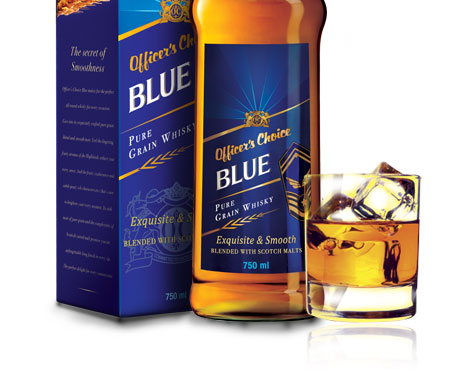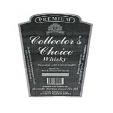
Th e plaintiff is the registered proprietor of the trademark ‘Officer’s Choice’. The mark has been used by the plaintiff since 1988 and the plaintiff obtained registration in 2007. In 2013, the plaintiff found out that the defendant had started selling whisky under the trademark ‘Collector’s Choice’. In order to restrain the defendant from infringing its mark, the plaintiff filed a suit for permanent injunction. (see order here). The court upheld the plaintiff’s arguments and extended the ex parte interim injunction till final decision. The court relied on consumer psychology and associative thinking in order to come to the conclusion that a ‘Collector’ could be confused with an ‘Officer’.
e plaintiff is the registered proprietor of the trademark ‘Officer’s Choice’. The mark has been used by the plaintiff since 1988 and the plaintiff obtained registration in 2007. In 2013, the plaintiff found out that the defendant had started selling whisky under the trademark ‘Collector’s Choice’. In order to restrain the defendant from infringing its mark, the plaintiff filed a suit for permanent injunction. (see order here). The court upheld the plaintiff’s arguments and extended the ex parte interim injunction till final decision. The court relied on consumer psychology and associative thinking in order to come to the conclusion that a ‘Collector’ could be confused with an ‘Officer’.
Plaintiff’s case
The defendant had been using the mark Collector’s Choice with respect to whisky and had filed an application for registration in 2011. The defendant was aware of the plaintiff’s mark as they cited the plaintiff’s mark in an answer to an objection. Moreover, by using the mark ‘Collector’s Choice’, it is not the case of defendant that its product is a ‘collector’s item’ instead, the defendant admitted that a Collector is an Officer. Hence the plaintiff argued that the defendant dishonestly used a mark similar to its mark. Cases were cited where the use of a part of the plaintiff’s registered mark as a prefix or suffix in the defendant’s mark was held to be infringement: Corn Products Refining Co. Vs. Shangrila Food Products Ltd. AIR 1960 SC 142, it was held that “Gluvita” and “Glucovita” were deceptively similar. In Amritdhara Pharmacy Vs. Satya Deo Gupta AIR 1963 SC 449, “Lakshmandhara” and “Amritdhara” were held to be deceptively similar. And in Durga Dutt Sharma Vs. Navaratna Pharmaceutical Laboratories AIR 1965 SC 980, “Navaratna Pharmacy” and “Navaratna Pharmaceutical Laboratory” were held to be deceptively similar. The plaintiff argued that though the word ‘Choice’ had been disclaimed, the consumers still associated the plaintiff’s product with the entire mark and the defendant itself was trying to register ‘Collector’s Choice’ as a mark.
Defendant’s case
The defendant contended that the word ‘Choice’ was disclaimed by the plaintiff i.e. the plaintiff did not have any monopoly over the word ‘Choice’. Since ‘Collector’ and ‘Officer’ are not phonetically or visually similar and the only common word is ‘Choice’, the marks are not deceptively similar. The defendant also contended that while plaintiff’s product ‘Officer’s Choice’ sells for Rs.202/-, the product of the defendant under the trade mark ‘Collector’s Choice’ sells for Rs.404/-. The IPAB decision of Allied Blenders & Distilleries Pvt. Ltd. Vs. John Distillers Ltd. 2013 (56) PTC 78 (IPAB), covered by us here, was cited where it was held that ‘Original Choice’ and Officer’s Choice’ as not similar and are capable of standing alone.
Court (JUSTICE RAJIV SAHAI ENDLAW)
The court upheld the arguments of the plaintiff and held that Officer’s Choice and Collector’s Choice could lead to a likelihood of confusion among consumers. In coming to its conclusion, the court relied on its decision in the ‘Old Monk’ v. ‘Told Mom’ trademark case, where it was held that the two marks were deceptively similar. Given the nature of consumers consuming Old Monk, the fact that a large number of Indians are still illiterate and the peculiar nature of the alcohol trade, the phonetic similarity between these two marks was likely to cause confusion among consumers.
In addition to this case, Justice Endlaw’s independent research on consumer psychology and associative thinking contributed significantly to conclude that ‘Officer’ and ‘Collector’ are deceptively similar and likely to confuse the target consumers.
Research on consumer psychology, brand association and memory
Several articles are cited by Justice Endlaw on consumer psychology and associative thinking. Some significant points, from the various sources cited are “…under the Associative Network Theories of memory: memory consists of nodes that hold information/concepts. If two pieces of information are “associated”, connections are conceptualized as existing between them, making up a network of associated information.” As a result “Due to the close semantic association between the concept “American” and “United States”, consumers exposed to an advertisement for American Airlines might attribute the advertisement to United Airlines […]”
“When a customer is exposed to the brand in a specific context, links in memory between the brand name and specific concepts can be created or reinforced. This network of information linked to the brand name constitutes what has been referred to as the brand’s image or as brand knowledge.”
Peculiarities of the alcohol market that affect associative thinking and consumer memory
Advertising of alcoholic products is banned in India. This means that manufacturers/suppliers of alcoholic beverages are unable to bombard consumers with their brand names, in order to enable consumers to remember/recall their brand. These trademarks are seen only when consumers go to purchase alcohol, and some of these shops may sell alcoholic products of only a particular manufacturer. In such cases the consumer is not able to place an Officer’s Choice bottle beside a Collector’s Choice bottle and distinguish between the two trademarks. These factors affect associative thinking and recall capacity of consumers.
Ruling
On the basis of this research, the court prima facie concluded that a consumer is likely to associate a ‘Collector’ with an ‘Officer’ and the possibility of the plaintiff’s trademark “Officer’s Choice” being remembered / recalled as “Collector’s Choice” cannot be ruled out. Since a Collector is the highest authority in a district, this may also lead consumers to believe that Collector’s Choice is a superior product of the same manufacturer of Officer’s Choice.
Moreover, the said product is not a high end alcoholic beverage and is of the lowest price range. Such consumers often purchase products not with the highest form of awareness. Moreover, the difference in price was not seen as big enough to lead consumers to distinguish the two products.
On the basis of these findings that court extended the ex parte interim injunction obtained by the plaintiff in 2013 till the suit is finally decided. The balance of convenience was in favour of the plaintiff as it had been in the trade for a long time, with large sales figures and had established reputation in the market. However, the defendant was a new entrant to the market, who had hardly used its mark and had not yet built any goodwill. Therefore, the loss to the plaintiff by allowing the defendant to use the mark during the pendency of the suit would be irreparable and hence the injunction was extended.
Thoughts
From this case, likelihood of confusion may arise not only due to phonetic, visual or aural similarity of the two marks but also if the idea behind the two marks is similar. If the main idea or impression left on consumers is the same, there may be a likelihood of confusion, notwithstanding the differences between the marks. So, trademarks such as “Aqua-Care” and “Water-Care” and “Beauty-Rest‟ and “Beauty Sleep” have been held to be deceptively similar.
Though each case it judged on its own facts and circumstances, is there a possibility of extending protection of a trademark to not only the word itself but also to its synonyms? For example, would a trademark for ‘Big Bazaar’ extend to ‘Large Bazaar’/‘Big Market’. Would the trademark for ‘Tide’ extend to prevent anyone from using the word ‘Wave’? Or would this amount to reading the ratio of this case too broadly? Since this case was on alcoholic beverages where advertising is banned, the same (use of synonyms/associated words) may not hold true for ordinary consumer goods where consumers are capable to discerning differences due to advertisements?

An interesting case…
(1) Both the marks look very different in appearance from the labels produced in the beginning of the post.
(2) Significance of the price difference of Rs. 200/- (almost 100% increase) has to be judged from the point of view of the class of consumers buying that liquor which in this case doesn’t appear to be the affluent class.
Price difference and class of consumers will not make a difference in such a case. The said test has been negated by the Bombay High Court in the Wodka Gorbatschow case.